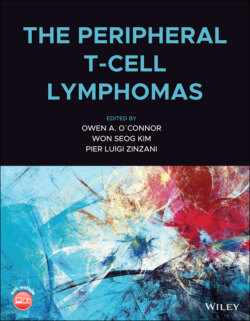Читать книгу The Peripheral T-Cell Lymphomas - Группа авторов - Страница 84
Mice Expressing HTLV‐1 Viral Proteins
ОглавлениеSeveral lines of transgenic mice expressing Tax under the control of viral promoters HTLV1 long terminal repeat have been developed. These mice develop mesenchymal tumors [30], arthritis [31], and osteoporosis [32]. Mesenchymal tumors were observed in the nose, ear, foot, and tail and were characterized by a spindle‐cell component and granulocyte infiltration. However, these models do not mimic human ATLL. Other investigators generated Tax transgenic mice using promoters activated in T cells [33, 34]. Among these, transgenic mice expressing Tax from the Cd3‐epsilon promoter developed a variety of tumors dependent on the lines, including mesenchymal tumors, and salivary and mammary adenomas [33]. Transgenic mice expressing Tax in thymocytes under control of the Lck proximal promoter developed thymic T‐cell lymphomas [34]. Moreover, the other transgenic mice expressing Tax using the GrzmB promoter developed large granular lymphocytic leukemia, lymphadenopathy, extranodal disease and hypercalcemia, resembling human ATLL [35, 36].
Transgenic mice expressing HBZ have also been developed [37, 38]. Mice expressing HBZ driven by the Cd4 promoter showed inflammatory lesions of lung and skin, accompanied by increase of effector/memory and regulatory CD4+ T cells [37]. Approximately 40% of these mice also develop T‐cell lymphomas after a long latency, reminiscent of human ATL. HBZ transgenic mice constructed using the GrzmB promoter were also reported [38] and exhibited lymphoproliferative disease, osteoporosis, splenomegaly, and hypercalcemia, similar to lymphoma‐type of ATLL. HBZ/Tax double transgenic mice in which both genes were controlled by the Cd4 promoter showed phenotypes similar to those of HBZ single transgenic mice [39]. Despite this progress, to date a model fully replicating human ATLL disease has not yet been established likely due to the complexity of the human ATLL disease.
